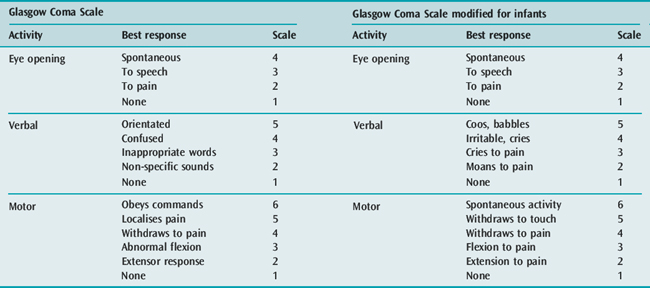Chapter 103 Paediatric trauma
The management of paediatric trauma is different from adults. Paediatric patients presenting with trauma have mechanisms of injury, clinical symptoms and examination findings which differ from adults, and differ across the range of their ages. Trauma is by far the leading cause of death in children over 1 year old, and the third leading cause less than 1 year after congenital abnormalities and sudden infant death syndrome.1 Causes of trauma and patterns of injury are determined by age-related behaviour, with falls and assaults more common in younger children, and motor vehicle accidents more common in older children. Injury patterns differ, with impact forces dissipated over a smaller target, severe organ damage resulting without bony fracture because bones are not ossified, and greater potential for hypothermia. In general, blunt trauma with multiorgan injury is most likely.
As with adults, there are three peak mortality periods after injury:
The mainstay of early management is optimising the ABC of resuscitation as outlined in other chapters. Importantly, vascular access can be difficult, and expertise in intraosseous needle insertion is essential.2
PREVENTION STRATEGIES
Paediatric trauma requires resources and separate systems to successfully reduce mortality and morbidity.3 New emphasis has seen the development of prevention strategies (Table 103.1), including:
Table 103.1 Prevention strategies4
| Paediatric injuries | Preventative strategies |
|---|---|
| MVA – occupant | Child car seat |
| Seatbelt restraints | |
| Car design | |
| Airbags | |
| MVA – pedestrian | Safety programmes in schools |
| Bicycle | Helmet |
| Separate sidewalks | |
| Playground | Equipment structural design |
| Soft surfaces | |
| Drowning | Surround pool fencing |
| Burns | Smoke detectors |
| Water tap regulators | |
| Flammable fabric legislation | |
| Poisoning | Preventative packaging |
| Violence | Hand gun legislation |
| Crisis resolution counselling |
HEAD INJURY
Significant head injury occurs in 75% of children admitted with blunt trauma,5 and 70% of these result in death. Causes of injury are determined by behaviour patterns, which change with age and are commonly due to falls and assaults in infants, and motor vehicle accidents (including bicycle-related injuries) in older children.
ASSESSMENT
This has led to attempts to modify the scale by either changing the scoring assessment signs, or by reducing the total score (i.e. eliminating some response categories).6 The latter does not allow for comparison of outcome data.
An example of a commonly used scale modified for infants is shown in Table 103.2. However, difficulties remain as regards the accuracy and reproducibility of GCS for infants. Clinical assessment must prioritise the signs and symptoms of cerebral oedema or raised intracranial pressure (ICP) (Table 103.3).
Table 103.3 Signs of raised intracranial pressure
MANAGEMENT
DIAGNOSTIC INVESTIGATIONS
A cranial computed tomography (CT) scan in stable patients excludes surgically treatable lesions, assesses the size of cerebrospinal fluid (CSF) spaces, including the basal cisterns, detects herniation and shift, and shows the presence of hyperaemia, oedema, intracerebral haematomas, contusions and fractures. A normal CT scan does not exclude raised ICP. Intracranial blood collections are less common than in adults.5 The following are poor prognostic signs:
CEREBRAL PERFUSION PRESSURE
Normal ICP is also lower,15 being normally less than 5 mmHg (0.67 kPa) at 2 years and less than 10 mmHg (1.3 kPa) at 5 years. Thus, in younger age groups, relative hypotension has a more profound effect on CPP and outcome,16 and hypotension may be the main cause of cerebral ischaemia. For adolescents, therapy should aim to sustain CPP at 60–70 mmHg (8.0–9.3 kPa), while maintaining normal blood volume and adequate blood pressure (with pressor agents if required). A CPP less than 40 mmHg (5.3 kPa) reduces the likelihood of intact survival. Younger patients should have therapeutic targets adjusted to age-related realistic end-points.
INTRACRANIAL PRESSURE
Mechanisms of raised ICP in childhood trauma are listed in Table 103.4. If ICP remains persistently raised and uncompensated, cerebral ischaemia and herniation result. This herniation can be cingulate, uncal (temporal lobe), cerebellar tonsillar, upward cerebellar (posterior fossa hypertension) or transcalvarian (through vault defects). Signs of herniation are as for raised ICP (Table 103.3).
Table 103.4 Mechanisms of raised intracranial pressure






